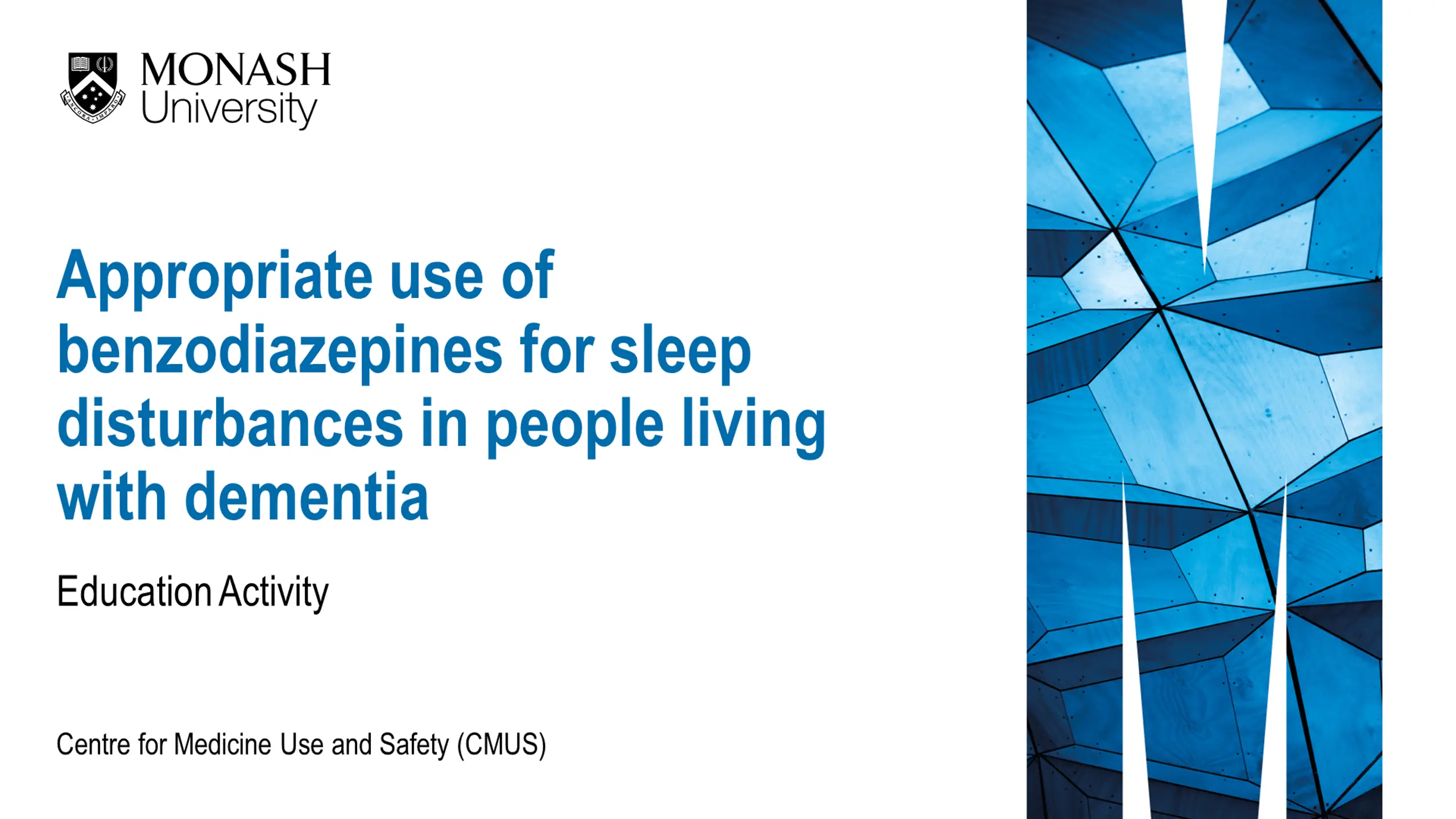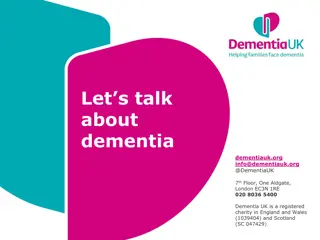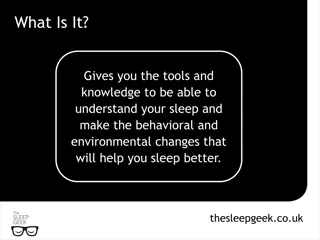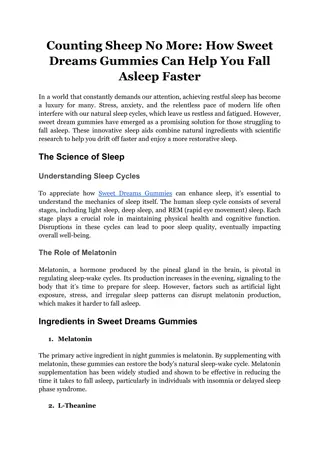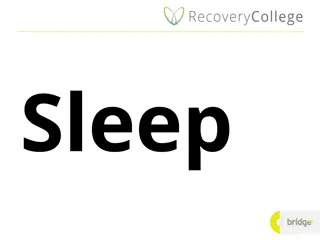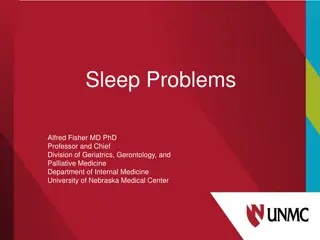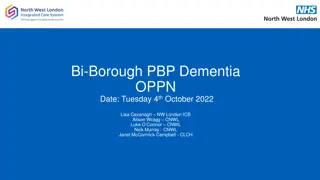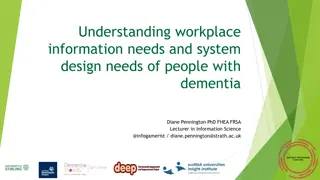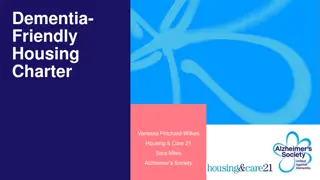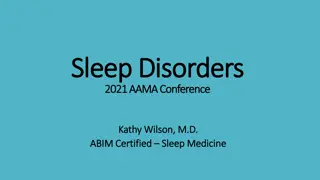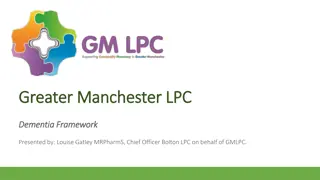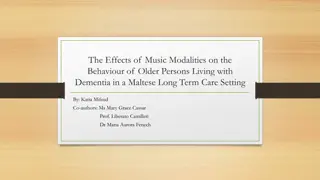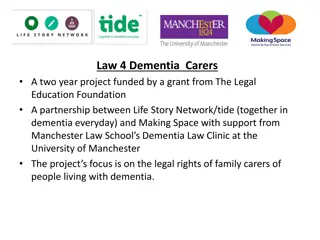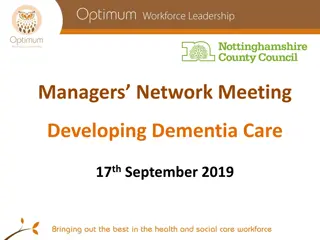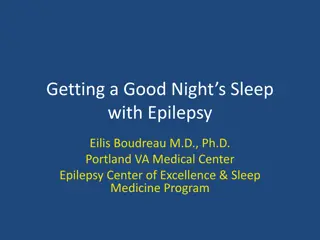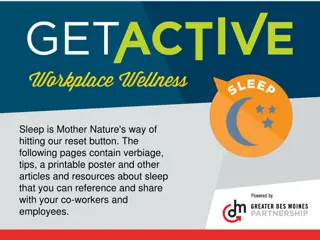Appropriate use of benzodiazepines for sleep disturbances in people living with dementia
The proper use of benzodiazepines for managing sleep disturbances in individuals living with dementia. This education activity by CMUS provides valuable information on the topic.
Download Presentation

Please find below an Image/Link to download the presentation.
The content on the website is provided AS IS for your information and personal use only. It may not be sold, licensed, or shared on other websites without obtaining consent from the author.If you encounter any issues during the download, it is possible that the publisher has removed the file from their server.
You are allowed to download the files provided on this website for personal or commercial use, subject to the condition that they are used lawfully. All files are the property of their respective owners.
The content on the website is provided AS IS for your information and personal use only. It may not be sold, licensed, or shared on other websites without obtaining consent from the author.
E N D
Presentation Transcript
Appropriate use of benzodiazepines for sleep disturbances in people living with dementia Education Activity Centre for Medicine Use and Safety (CMUS)
Introduction Background Dementia is associated with a deterioration in:1,2 o Memory o Communication o Thinking o Ability to perform daily activities o Behaviour
Introduction Dementia and changed behaviours People living with dementia often experience changed behaviours. Changed behaviours are diverse and may include: o Wandering e.g. walking aimlessly and/or excessively, attempting to exit a safe location3 o Sleep disturbances e.g. difficult falling or staying asleep3 o Agitation e.g. excessive fidgeting, pacing, irritability3 o Aggression e.g. verbal insults, swearing, punching, throwing objects2,3
Introduction Care for people living with dementia and changed behaviours Care for people living with dementia and changed behaviours can be split into two broad strategies: Non-pharmacological strategies Pharmacological strategies Definition: medication strategies Definition: non-medication strategies Example: psychotropic medications Examples: pet therapy, exercise therapy, art therapy2,3 Royal Commission into Aged Care Quality and Safety defines a psychotropic medication as: Any drug capable of affecting the mind, emotions, and behaviour 4
Introduction Use of Psychotropic Medications in People Living with Dementia and in Residential Aged Care The Royal Commission into Aged Care Quality and Safety Interim Report: Neglect5highlighted an overreliance on psychotropic medications Psychotropic medications such as benzodiazepines are associated with adverse outcomes for people living with dementia: o Sedation e.g. drowsiness, sleepiness o Falls o Fractures
Introduction Clinical Practice Guideline for Appropriate Use of Psychotropic Medications in People Living with Dementia and in Residential Aged Care Three most common psychotropic medications implicated in restrictive practice in residential aged care are: o Antipsychotics o Benzodiazepines o Antidepressants4 The new clinical practice guideline focuses on the appropriate medication use of antipsychotics, benzodiazepines and antidepressants
Learning Objectives By the end of this session, you should be able to: 1. Explain the criteria that should be met before using a benzodiazepine for people living with dementia and sleep disturbances 2. Specify the criteria for escalating care surrounding initiation of a benzodiazepine 3. Explain what should be documented surrounding initiation of an benzodiazepine 4. Be aware of supporting resources accompanying the Guideline to use in everyday practice
Initiation of benzodiazepines Image from freepik
Group discussion what is a benzodiazepine?
What is a benzodiazepine? A benzodiazepine is a class of medication that slows down the workings of the brain6 Benzodiazepines can cause: o Excess sedation e.g. drowsiness, sleepiness o Physical dependence7 o Tolerance7 Sometimes benzodiazepines are prescribed to people living with dementia and changed behaviours One Australian study8reports that 30% of residents are dispensed benzodiazepines within three months of admission to residential aged care Some examples of benzodiazepines are temazepam, oxazepam, lorazepam and diazepam4,9
Multiple choice question When should benzodiazepines be considered for sleep disturbances in people living with dementia? Select the most correct option: a. When a person is first diagnosed with dementia as most people living with dementia eventually develop sleep disturbances b. When a person living with dementia and sleep disturbances starts to wander c. When a person living with dementia experiences sleep disturbances for the first time d. As a last resort when all other non-pharmacological strategies have been trialled for an adequate period of time e. B and D Answer: D
Multiple choice question - answer Why is option D correct? Benzodiazepines should only be considered: Benzodiazepines should NOT be considered for people living with dementia who are: As a last resort for people living with dementia who are experiencing sleep disturbances Initially diagnosed with dementia and not experiencing sleep disturbances Experiencing sleep disturbances and wander for the first time Experiencing sleep disturbances for the first time If a decision is made to initiate a benzodiazepine for changed behaviours, the prescriber must clearly indicate the reason for prescribing the benzodiazepine
Harms vs Benefits of Benzodiazepines May improve: Increase the risk of : o Sleep disturbances10 o Hip fracture12 o Agitation11 o Falls13 o Excess sedation; drowsiness, sleepiness o Daytime drowsiness BENEFITS HARMS
Steps before initiating a benzodiazepine Clinical steps When a person living with dementia is displaying sleep disturbances for the first time, contact the prescriber to rule out acute causes for the behaviour e.g. delirium, infection3 After these have been excluded, all staff should trial the following measures for an adequate and agreed period of time: Identify potential underlying causes; unmet needs e.g. loneliness, need for meaningful activity environmental factors e.g. noisy environment medical conditions e.g. pain, adverse events to medications Non-pharmacological strategies; tailor non-pharmacological strategies to the person e.g. relaxation therapy, music therapy you may be able to refer to a dementia specialist within the residential aged care facility Dementia Support Australia (DSA)14 Get the entire care team involved!
Steps before initiating a benzodiazepine Communication and documentation steps Document clinical steps trialled and the sleep disturbance the person is experiencing in the (where applicable); medical record nursing progress notes behaviour support plan Discuss the person s sleep disturbance with the entire care team (including the prescriber) Document conversations and the plan going forward Get the entire care team involved!
Case study Dimitri Popov is a person living with vascular dementia at Sunnyside residential aged care facility Dimitri worked as a strawberry farmer and spent most of his working life getting up early in the morning Dimitri enjoys drinking multiple cups of coffee throughout the day. Dimitri explains, there s not too much to do around here, so the coffee keeps me awake! Dimitri s room is situated close to the nurses station. Often, Dimitri s room door is left open during the night Image from freepik
Case study Small groups Read the Case Study Discuss questions 1 and 2 over the next 15 minutes Prepare answers to share in group discussion
Review of case study questions Group Discussion Question 1. Should a benzodiazepine be prescribed for Dimitri s sleep disturbance? What would you communicate and document?
Review of case study questions Group Discussion Question 1. Should a benzodiazepine be prescribed for Dimitri s sleep disturbance? What would you communicate and document? Clinical steps No Communication and documentation steps Document Dimitri s sleep disturbance in the medical record, nursing progress notes and behaviour support plan where applicable e.g. Dimitri was experiencing xxxxxx Prescribing, dispensing or administering a benzodiazepine in this case should not be considered Contact the prescriber Non-pharmacological strategies should be trialled for an adequate period of time first Notify the care team Benzodiazepines should only be used as a last resort for people living with dementia who are experiencing sleep disturbances
Review of case study questions Group Discussion Question 2. List some management strategies you should try first before considering a benzodiazepine for Dimitri. How would you communicate and document this?
Review of case study questions Group Discussion Question 2. List some management strategies you should try first before considering a benzodiazepine for Dimitri. How would you communicate and document this? Clinical steps All staff should trial the following measures and for an adequate and agreed period of time: Investigate possible underlying causes of sleep disturbance such as; could Dimitri s door be closed at night to reduce noise and light entering his room? Could a night light be used instead? could Dimitri s coffees at night be swapped for a non-caffeinated drink? could staff encourage Dimitri to engage in group activities? could Dimitri be provided with his favourite newspaper each morning to read? what time would Dimitri usually wake up at home? Non-pharmacological strategies could staff encourage Dimitri to spend time in the garden?
Review of case study questions Group Discussion Question 2. List some management strategies you should try first before considering a benzodiazepine for Dimitri. How would you communicate and document this? Communication and documentation steps Document clinical steps trialled and the sleep disturbance Dimitri is experiencing in the (where applicable); medical record nursing progress notes behaviour support plan Contact the prescriber Notify the care team Document conversations and plan going forward We spoke with Dimitri s wife, Irene, about Dimitri s morning routine at home. She explained Dimitri usually woke up at 5am and he enjoyed eating breakfast while reading the newspaper called The Sunshine and overlooking the farm. Contacted newsagent and the newspaper will be delivered each morning from tomorrow. Please trial encouraging Dimitri to sit overlooking the garden on the mornings he wakes up early
Update on Dimitri Dimitri was delighted when staff delivered his favourite newspaper to him the next morning. When Dimitri requested coffees later in the day, staff offered Dimitri an alternative non- caffeinated drink that Dimitri enjoyed growing up in his home country. Nurse Jenny observed, I thought Dimitri needed a benzodiazepine. I doubted non- pharmacological strategies would work for him. But they have been great. And even on the odd morning when Dimitri wakes up early, he responds well to sitting overlooking the garden. It s great to see that all our detective work has paid off! Image from freepik
Prescribers' responsibilities surrounding benzodiazepine initiation What steps should prescribers complete and document before initiating a benzodiazepine? Clinical steps Communication and documentation steps Identify the specific changed behaviour they want to improve (target symptom) Does Dimitri have sleep disturbances? Have all other measures been trialled for an adequate and agreed period of time? Have a comprehensive discussion with the person living with dementia, support person and/or their substitute decision maker Obtain informed consent Identify the anticipated treatment outcome What benefit does Dr. Mary want to see as a result of Dimitri taking the benzodiazepine? Document treatment review date Document treatment end date The prescriber, supply pharmacist and nurse should be document the treatment end date in the medical record, pharmacy dispensing history and nursing progress notes, respectively. Complete an individual harm-benefit analysis What are Dimitri s individual risks and benefits of taking the benzodiazepine? What other medications is Dimitri taking? If the prescriber initiates a benzodiazepine, initial treatment duration for sleep disturbance should not exceed 2 weeks
Take home messages There is a limited role for benzodiazepines for sleep disturbances Before considering initiation of a benzodiazepine, all staff should trial for an adequate and agreed period of time: Identify and address possible underlying causes for sleep disturbance Implement non-pharmacological strategies Benzodiazepines should only be considered as a last resort for people living with dementia who are experiencing sleep disturbances
Supporting resources Access to the Guideline
References 1. The Royal Commission into Aged Care Quality and Safety. Background Paper 3: Dementia in Australia: Nature, Prevalence and Care. Commonwealth of Australia; 2019. Accessed December 9, 2022. https://agedcare.royalcommission.gov.au/sites/default/files/2019-12/background-paper-3.pdf 2. New South Wales Ministry of Health. Assessment and Management of Behaviours and Psychological Symptoms associated with Dementia (BPSD). New South Wales Government; 2022. Accessed January 25, 2023. https://www.health.nsw.gov.au/mentalhealth/resources/Publications/assessment-mgmt-people-bpsd-2022.pdf. 3. Burns K, Jayasinha R, Tsang R, Brodaty H. Behaviour Management A Guide to Good Practice: Managing Behavioural and Psychological Symptoms of Dementia. Dementia Support Australia; 2012. Accessed September 19, 2022. https://www.dementia.com.au/resource-hub/behaviour-management-a-guide-to-good-practice 4. Aged Care Quality and Safety Commission. Psychotropic medications used in Australia: information for aged care. Australian Government; 2021. Accessed September 2, 2022. https://www.agedcarequality.gov.au/resources/psychotropic-medications-used-australia-information-aged-care 5. The Royal Commission into Aged Care Quality and Safety. Interim Report: Neglect. Commonwealth of Australia; 2019. Accessed September 19, 2022. https://agedcare.royalcommission.gov.au/publications/interim-report 6. Department of Health, State Government of Victoria. Benzodiazepines. Better Health Channel. Updated October 26, 2020. Accessed October 27, 2022. https://www.betterhealth.vic.gov.au/health/healthyliving/tranquillisers#what-are-benzodiazepines 7. Depressants. Alcohol and Drug Foundation; 2022. Accessed January 13, 2023. https://adf.org.au/drug-facts/depressants/ 8. Harrison, SL, Sluggett, JK, Lang, C, et al. The dispensing of psychotropic medicines to older people before and after they enter residential aged care. Med J Aust. 2020;212(7):309-313. doi: 10.5694/mja2.50501 9. Australian Medicines Handbook. Australian Medicines Handbook Pty Ltd. Updated January 2023. Accessed February 10, 2023. https://amhonline.amh.net.au.acs.hcn.com.au 10. Glass J, Lanct t KL, Herrmann N, Sproule BA, Busto UE. Sedative hypnotics in older people with insomnia: meta-analysis of risks and benefits. BMJ. 2005; 331(7526):1169. doi: 10.1136/bmj.38623.768588.47 11. Meehan KM, Wang H, David SR, et al. Comparison of rapidly acting intramuscular olanzapine, lorazepam, and placebo: a double-blind, randomized study in acutely agitated patients with dementia. Neuropsychopharmacology. 2002;26(4):494-504. doi: 10.1016/S0893-133X(01)00365-7 12. Donnelly K, Bracchi R, Hewitt J, Routledge PA, Carter B. Benzodiazepines, Z-drugs and the risk of hip fracture: A systematic review and meta-analysis. PLoS One. 2017;12(4):e0174730. doi: 10.1371/journal.pone.0174730 13. Seppala LJ, Wermelink AMAT, de Vries M, et al. Fall-Risk-Increasing Drugs: A Systematic Review and Meta-Analysis: II. Psychotropics. J Am Med Dir Assoc. 2018;19(4):371.e11-371.e17. doi: 10.1016/j.jamda.2017.12.098 14. Dementia Support Australia. Helping you care for people with dementia. Dementia Support Australia. Accessed February 2, 2023. https://www.dementia.com.au/who-we-help/dementia-healthcare- professionals?hsCtaTracking=c0d1774a-0ac3-4c51-ade3-7370dee3ce26%7C5fd0cceb-a3e2-40d7-a516-d4845624ccef Unless specified, all icons included in this presentation are from Flaticon.com
